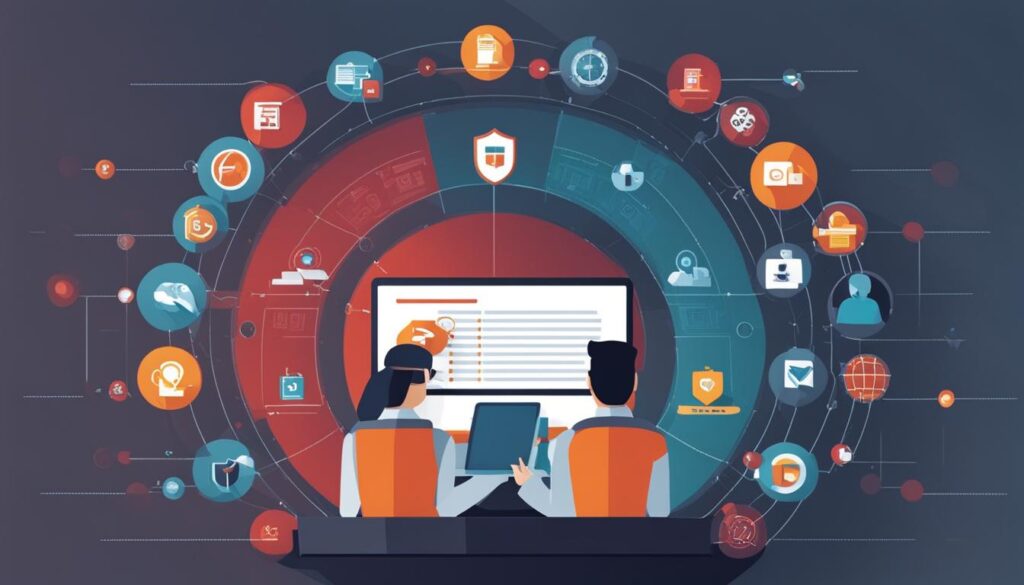Welcome to the world of information technology (IT), where various branches work together to drive our tech-driven society forward. In this article, we will explore the specific roles and contributions of each branch in the IT industry. Dive in with us and discover what each branch of information technology does.
Contents
- 1 Computer Science: The Foundation of IT
- 2 Software Development: Building Innovative Applications
- 3 Network Administration: Keeping Systems Connected
- 4 Cyber Security: Protecting Digital Assets
- 5 Database Management: Organizing and Analyzing Data
- 6 Web Development: Creating Engaging Online Experiences
- 7 FAQ
- 7.1 What are the different branches of information technology and what do they do?
- 7.2 What is computer science and what is its role in IT?
- 7.3 What is software development and what do software developers do?
- 7.4 What is network administration and what is the role of network administrators?
- 7.5 What is cyber security and what do cyber security professionals do?
- 7.6 What is database management and what do database administrators do?
- 7.7 What is web development and what do web developers do?
- 8 Source Links
Key Takeaways
- Information technology encompasses various branches, each with unique roles and contributions.
- Computer science forms the foundation of all IT branches, focusing on algorithms, programming languages, and software development.
- Software development involves creating, testing, and maintaining computer applications and systems.
- Network administration ensures the smooth operation of computer networks, optimizing performance and addressing connectivity issues.
- Cyber security professionals protect digital assets and safeguard computer systems from unauthorized access and cyber threats.
Computer Science: The Foundation of IT
Computer science serves as the backbone of all IT branches. It encompasses the study of algorithms, data structures, programming languages, and software development. Computer scientists play a critical role in the advancement of technology by developing innovative solutions and designing complex computer systems. They utilize their expertise to create new technologies that enhance efficiency and solve real-world problems.
In computer science, algorithms are the step-by-step procedures used to perform calculations, data processing, and automated reasoning. These algorithms are the building blocks of computer programs and form the core of various IT applications. Data structures, on the other hand, are specialized formats for organizing, storing, and manipulating data efficiently. They allow for quick access and retrieval of information, optimizing system performance.
Programming languages serve as the tools for computer scientists to communicate with computers. These languages enable the creation of software applications, websites, and other IT solutions. Examples of popular programming languages include Python, JavaScript, and Java.
Software development, a branch closely related to computer science, focuses on the creation, testing, and maintenance of computer programs and systems. It applies the knowledge of computer science to transform algorithms, data structures, and programming languages into functional software applications.
Computer science is at the heart of innovation, driving the evolution of technology and fueling the growth of various IT branches. It provides the foundation upon which other IT disciplines are built, allowing for continuous advancements and new possibilities.
The Role of Computer Scientists in IT Branches
Computer scientists are involved in a wide range of IT branches, including:
- Artificial Intelligence: Developing intelligent systems, machine learning algorithms, and natural language processing.
- Data Science: Analyzing and interpreting large datasets, extracting meaningful insights, and making data-driven decisions.
- Computer Vision: Creating algorithms and models for image and video processing, object recognition, and augmented reality applications.
- Human-Computer Interaction: Designing intuitive user interfaces and improving the interaction between humans and computers.
| IT Branch | Key Contributions of Computer Science |
|---|---|
| Artificial Intelligence | Creation of intelligent algorithms, development of machine learning models, and advancement of natural language processing techniques. |
| Data Science | Application of data analysis and statistical techniques, development of algorithms for data mining and visualization, and utilization of machine learning algorithms to extract insights. |
| Computer Vision | Design of image and video processing algorithms, development of computer vision models for object detection and recognition, and enhancement of augmented reality experiences. |
| Human-Computer Interaction | Integration of usability principles, development of user-friendly interfaces, and improvement of user experiences through interaction design. |
Computer science is an ever-evolving field, constantly pushing the boundaries of technological capabilities. As new challenges and opportunities arise, computer scientists continue to innovate, creating the next generation of IT solutions that shape our digital world.
Software Development: Building Innovative Applications
Software development is a vital aspect of the IT industry that involves the creation, testing, and maintenance of computer applications and systems. It encompasses the entire process of designing, coding, and deploying software solutions to meet the ever-evolving needs of businesses and end-users.
Software developers play a pivotal role in transforming ideas into reality. They possess in-depth knowledge of programming languages, frameworks, and tools that empower them to build cutting-edge applications. By utilizing their expertise, software developers ensure that software programs are user-friendly, efficient, and innovative.
One of the key responsibilities of software developers is to understand the requirements of clients and end-users. By collaborating closely with them, developers gain valuable insights into their needs, preferences, and pain points. This understanding serves as a foundation for creating custom software programs that address specific requirements and provide tailored solutions.
Throughout the software development lifecycle, developers follow best practices and adhere to industry standards. They engage in rigorous testing to identify and resolve any bugs or issues, ensuring the reliability and functionality of the software. Additionally, developers stay updated with the latest advancements in technology to incorporate new features and enhancements into their applications.
“Software development is a creative process that combines technical expertise with a deep understanding of user needs. It allows us to build innovative applications that improve efficiency, enhance user experiences, and drive business growth.”
To provide a comprehensive overview of software development, here is a table highlighting the key stages of the software development lifecycle:
| Stage | Description |
|---|---|
| Requirement Gathering | Gathering and documenting the software requirements based on client and end-user needs. |
| Design | Creating a blueprint for software architecture, user interface, and database design. |
| Development | Writing code and implementing the design to build the software application. |
| Testing | Conducting various tests to identify and fix any defects or issues in the software. |
| Deployment | Releasing the software application for end-users to access and utilize. |
| Maintenance | Providing ongoing support, bug fixes, and updates to ensure optimal performance. |
Software development plays a crucial role in leveraging technology to drive innovation, improve efficiency, and meet the ever-growing demands of the digital age. Whether it’s mobile applications, web-based solutions, or enterprise software, software developers are instrumental in building the applications that power our modern world.

Network Administration: Keeping Systems Connected
Network administration, an essential branch of information technology (IT), focuses on managing and maintaining computer networks, including hardware, software, and communication systems. Network administrators play a crucial role in ensuring the smooth operation of networks, troubleshoot connectivity issues, implement robust security measures, and optimize network performance.
With the increasing reliance on technology in today’s interconnected world, network administrators are the backbone of organizations, ensuring seamless data transfer and uninterrupted communication. Their expertise in network design, configuration, and maintenance allows businesses to function efficiently and securely.
Network administrators are responsible for:
- Setting up and configuring network routers, switches, and firewalls to enable secure and reliable communication.
- Monitoring network traffic and performance to identify and resolve bottlenecks and connectivity issues.
- Implementing security measures such as firewalls, intrusion detection systems, and virtual private networks (VPNs) to protect against cyber threats.
- Managing user access and permissions to ensure data confidentiality and integrity.
- Performing regular backups and disaster recovery planning to minimize data loss and downtime.
Network administrators work closely with IT teams and other departments to understand their requirements and provide technical support. They diagnose and troubleshoot network problems, conduct network optimizations, and stay updated with the latest advancements in network technologies.
Network administration is a dynamic field that requires a deep understanding of network protocols, operating systems, and security frameworks. Professionals in this role often hold certifications such as Cisco Certified Network Associate (CCNA) and Certified Information Systems Security Professional (CISSP) to validate their skills and expertise.
As technology continues to evolve, the demand for skilled network administrators remains high. Their expertise in keeping systems connected and secure is invaluable for organizations of all sizes across various industries.
Remember:
Network administration is a critical IT branch that ensures the efficient operation and security of computer networks. Network administrators play a vital role in keeping systems connected, troubleshooting connectivity issues, implementing robust security measures, and optimizing network performance.

Cyber Security: Protecting Digital Assets
In today’s interconnected world, cyber security plays a crucial role in safeguarding digital assets and protecting computer systems from various threats. As technology continues to advance, the need for skilled cyber security professionals becomes increasingly important. Companies and organizations rely on these experts to develop robust security protocols, implement advanced firewalls and encryption methods, and monitor networks for vulnerabilities.
The responsibilities of cyber security professionals extend beyond prevention. They also play a vital role in responding to security incidents and mitigating the impact of cyber attacks. In the event of a breach, they analyze the situation, identify the source of the attack, and take immediate action to secure compromised systems.
“With the rising prevalence of cyber threats, organizations need skilled cyber security professionals to protect their sensitive data and maintain customer trust.”
Cyber security professionals are well-versed in applying the latest technologies and industry best practices to combat ever-evolving threats. They proactively assess potential vulnerabilities, conduct security audits, and recommend appropriate measures to ensure the integrity and confidentiality of data.
Importance of Cyber Security in IT Branches
Cyber security is a critical component in every branch of information technology. Without proper security measures, computer networks, software applications, and databases are susceptible to unauthorized access, data breaches, and financial losses.
Let’s take a closer look at how cyber security is essential in the different IT branches:
- Computer Science: Cyber security is integrated into computer science education and research. It allows computer scientists to develop secure systems and analyze potential threats.
- Software Development: Cyber security practices and principles are vital during the development lifecycle, ensuring that software applications are resilient to attacks.
- Network Administration: Network administrators rely on cyber security to protect networks from unauthorized access and prevent data leakage.
- Database Management: Cyber security protocols protect databases from data breaches, ensuring confidentiality and integrity of sensitive information.
- Web Development: Cyber security measures are implemented to safeguard websites and web applications from malicious activities.
Future of Cyber Security
As technology continues to advance, the risk landscape also evolves. From sophisticated cyber attacks to emerging technologies, there is an ongoing need to adapt and enhance cyber security measures. The demand for skilled cyber security professionals is expected to grow significantly in the coming years.

| Emerging Cyber Threats | Impact on IT Systems |
|---|---|
| Malware and ransomware | System downtime and data loss |
| Social engineering attacks | Identity theft and financial fraud |
| Internet of Things (IoT) vulnerabilities | Compromised devices and privacy breaches |
The future of cyber security will involve continuous innovation and collaboration to stay one step ahead of cyber criminals. Constant learning and adaptation will be necessary to protect digital assets and ensure the security and privacy of individuals and organizations.
Database Management: Organizing and Analyzing Data
Database management is a critical component of IT branches, focusing on organizing, storing, and analyzing vast amounts of data. In today’s data-driven world, businesses rely on databases to efficiently retrieve and utilize information for decision-making and operational processes.
Database administrators (DBAs) play a vital role in designing and maintaining databases, ensuring optimal performance and data integrity. They define data structures, implement security measures, and enforce data governance policies to protect valuable organizational information.
DBAs are responsible for optimizing database performance, fine-tuning queries, and indexing data for faster retrieval. They monitor database activity, identify potential bottlenecks, and troubleshoot issues to maintain seamless operations.
“Database administrators are the unsung heroes behind the scenes, ensuring that data is organized, secure, and readily available when needed,” says Maria Thompson, a renowned expert in database management.
“Effective database management enables businesses to gain actionable insights, improve efficiency, and drive strategic decision-making. It’s the backbone of successful data-driven organizations.”
Database management encompasses various techniques and technologies to ensure efficient data storage and analysis. With the rise of big data and advancements in cloud computing, DBAs are continually adapting to evolving trends and implementing innovative solutions.
Key Responsibilities of Database Administrators:
- Designing and implementing database structures.
- Ensuring data security and privacy.
- Optimizing database performance.
- Monitoring and troubleshooting database systems.
- Defining data governance policies.
- Implementing backup and recovery strategies.
By proficiently managing databases, DBAs contribute to the smooth functioning of organizations across various industries, including finance, healthcare, e-commerce, and telecommunications.
Database Management Industry Outlook:

The field of database management is expected to witness significant growth in the coming years as businesses continue to accumulate and analyze vast amounts of data. According to industry projections, the global database management market is estimated to reach USD 128.68 billion by 2026, with a compound annual growth rate (CAGR) of 10.35% during the forecast period.
The increasing need for efficient data management, advancements in data analytics technologies, and the adoption of cloud-based database solutions are driving the demand for database management professionals.
As organizations recognize the value of data-driven insights, the role of database administrators becomes even more crucial in ensuring the accuracy, security, and accessibility of valuable information.
Web Development: Creating Engaging Online Experiences
In today’s digital age, web development plays a vital role in creating visually stunning and functional websites that captivate users. Web developers are the architects behind the scenes, utilizing coding languages such as HTML, CSS, and JavaScript to build user-friendly interfaces and interactive features that enhance the overall user experience.
By collaborating with designers and content creators, web developers bring together aesthetics and functionality, ensuring that websites align with business objectives and effectively engage the target audience. They work diligently to optimize website performance, responsiveness, and compatibility across various devices, delivering seamless experiences that keep users coming back for more.
Whether it’s an e-commerce platform, a corporate website, or a personal blog, web developers blend creativity and technical expertise to transform concepts into reality. From designing intuitive navigation systems to integrating multimedia elements, they continuously strive to create immersive online experiences that leave a lasting impression. With an ever-growing demand for compelling web experiences, the role of web development remains at the forefront of the IT industry.
FAQ
What are the different branches of information technology and what do they do?
The different branches of information technology include computer science, software development, network administration, cyber security, database management, and web development. Each branch has a specific role in the industry, such as developing computer systems, creating software applications, managing network infrastructure, protecting digital assets, organizing and analyzing data, and designing engaging websites.
What is computer science and what is its role in IT?
Computer science serves as the foundation of all IT branches. It focuses on the study of algorithms, data structures, programming languages, and software development. Computer scientists develop innovative solutions, design computer systems, and create new technologies to enhance efficiency and solve complex problems.
What is software development and what do software developers do?
Software development involves the creation, testing, and maintenance of computer applications and systems. Software developers use programming languages and coding to design user-friendly and innovative software solutions. They work closely with clients and end-users to understand their needs and develop custom programs that meet specific requirements.
What is network administration and what is the role of network administrators?
Network administration focuses on managing and maintaining computer networks, including hardware, software, and communication systems. Network administrators ensure the smooth operation of networks, troubleshoot connectivity issues, implement security measures, and optimize network performance. They play a crucial role in keeping systems connected and ensuring seamless data transfer.
What is cyber security and what do cyber security professionals do?
Cyber security professionals are responsible for safeguarding digital assets and protecting computer systems from unauthorized access, data breaches, and cyber threats. They develop security protocols, implement firewalls and encryption, monitor networks for vulnerabilities, and respond to security incidents. Their role is paramount in the age of digital information and increasing cyber threats.
What is database management and what do database administrators do?
Database management involves organizing, storing, and analyzing large amounts of data to ensure efficient retrieval and utilization. Database administrators design and maintain databases, define data structures, implement security measures, and optimize database performance. Their expertise is crucial in managing and protecting valuable organizational information.
What is web development and what do web developers do?
Web development is focused on creating and maintaining visually appealing and functional websites. Web developers use coding languages such as HTML, CSS, and JavaScript to build user-friendly interfaces and interactive features. They collaborate with designers and content creators to deliver engaging online experiences that meet business objectives.




